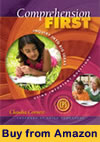 Comprehension is a multifaceted process that relies on many thinking strategies, which have sometimes been referred to as problem solving. The Comprehension Problem Solving (CPS) process described in the chart below is an inquiry-based approach to comprehension. It acknowledges that comprehending content is the central “problem” all readers face when approaching any text, be it fiction, nonfiction, word-based, or wordless; thus, problem-solving strategies are necessary to achieve this comprehension goal.
Comprehension is a multifaceted process that relies on many thinking strategies, which have sometimes been referred to as problem solving. The Comprehension Problem Solving (CPS) process described in the chart below is an inquiry-based approach to comprehension. It acknowledges that comprehending content is the central “problem” all readers face when approaching any text, be it fiction, nonfiction, word-based, or wordless; thus, problem-solving strategies are necessary to achieve this comprehension goal.
The CPS process organizes thinking strategies into before, during, and after (BDA) stages, but successful comprehenders use the process flexibly. Good readers frequently skip around and move back and forth in their use of thinking strategies. Capable comprehenders return to and revise their purposes and predictions as they process more text, in a “review and add to” manner.
Post the chart below in your classroom or use it to prepare a handout for students. Help students use the guiding questions for each strategy before, during, and after reading, viewing, or listening to a text. Using the CPS process outlined in the chart, students will learn to employ a repertoire of problem solving strategies to make sense of texts.
BEFORE reading, viewing, or listening to a text
Purpose-set. Create motivation, by focusing on the goal of comprehension.
* What’s the problem? Why am I using this text?
Predict and connect. Overview the text to activate prior knowledge. Link the text
to your own experiences, to other texts, and to what you know about the world.
* What is the text like, and how is the text organized?
* What do I already know about this problem or topic?
* What information or experiences do I predict this text will provide?
DURING reading, viewing, or listening to a text:
Gather data by taking and making meaning from the text
Determine important concepts. Use text clues as evidence.
* What does the author want me to think? Why?
* What do I think are key concepts or topics that might lead to big ideas?
* What facts or details (evidence) make me think these concepts or topics are key?
Infer conclusions. Use previous evidence to decide.
* What do I predict so far?
Image. Use your imagination to think about the text.
* What visual images can I make in my head?
* What feelings, smells, tastes, and sounds do I connect to the text?
Question and wonder. Speculate by questioning.
Ask the Five W + H questions (who, what, when, where, why, and how).
* What predictions about important ideas are confirmed? Which ones should be rejected?
* What new predictions can I make about what is most important in the text?
* What new connections can I make (text–self, text–text, text–world)?
Monitor. Check whether you are making sense.
Am I understanding? If not . . .
* Which Comprehension or Word Fix-Ups should I use?
Analyze/critique. Zoom in–zoom out. Use text features and structures.
* If the text is narrative: What do I know about the characters? What are the problems?
Where and when is the story happening? How are problems being resolved?
What themes are emerging?
* If the text is expository: How is it organized (e.g., sequential, cause/effect, comparison)?
* If the text is non-verbal: What stands out? How does the text feel? Why?
* Overall: What are the important details and features? How are they related to the
big ideas I’m finding and creating?
Incubate. Take time out.
* How can I take a break so I can review and reconsider from a fresh perspective?
Synthesize. Pull big ideas together.
* What are the most important concepts, themes or generalizations, and conclusions?
* What big idea statements are most important?
AFTER reading, viewing, or listening to a text
Organize and shape. Transform the big ideas.
* How can I best show my understanding of the most important big ideas?
Reflect and revise. Think about the comprehension product.
* What works or makes sense? What doesn’t work?
* How can I better show my comprehension?
Publish. Make your comprehension public.
* How can I share my comprehension “product”? With whom? When? Where?

